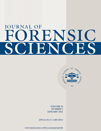The Conviction of Dr. Crippen: New Forensic Findings in a Century-Old Murder
Abstract
Abstract: Dr. Hawley Crippen was accused and convicted of murdering his wife in London in 1910. Key to the conviction was microscopic analysis of remains found in the Crippen’s coal cellar, which were identified as Cora Crippen based on a scar she was said to have. Dr. Crippen was hanged, always proclaiming his innocence. In this study, genealogical research was used to locate maternal relatives of Cora Crippen, and their mitochondrial haplotypes were determined. Next, one of the pathology slides of the scar was obtained, DNA was isolated, and the haplotype was determined. That process was then repeated. Finally, both DNA isolates were assayed for repetitive elements on autosomes and repetitive elements specific to the Y chromosome. Based on the genealogical and mitochondrial DNA research, the tissue on the pathology slide used to convict Dr. Crippen was not that of Cora Crippen. Moreover, that tissue was male in origin.




